Does Hair transplant Last Forever as permanent?

Hair transplant is a surgery that employs micrografting technology to transplant the patient’s hair follicles to thinning regions of the head. The effects of a hair transplant are visible and are thought to be permanent. The operation is very time-consuming and requires healing and time for recovery. Because of this, those who have previously suffered considerable thinning of their scalp hair are the most likely candidates for a hair transplant.
Is Hair Transplant Permanent?
Once the hair follicles are grafted into the areas where the thinning of hair occurs, it usually takes some time for the skin of the scalp to heal. It is even expected and thought as normal for your transplanted hair to fall out within the first three months after your FUE hair transplant surgery.
Recovery might take between 6 and 12 months. The best results are seen after one year post-surgery. Once the transplanted follicles have healed, they will begin to develop hair, filling in the bald regions on your head. However, the transplanted hair follicles, like the rest of your hair follicles, have a lifespan. They may eventually cease generating as much hair as they used to.
Do Hair Transplants Wear Off?
Your skin will require to heal once your hair follicles are transplanted into hair-loss areas. Indeed, it is normal for some of your hair to fall out within the first three months after surgery. Unfortunately, transplanted hair follicles have a lifetime, just like the rest of your hair follicles. Hair transplants are typically permanent, so for the best results, you should consider undergoing the surgery with a skilled and experienced surgeon. For this reason, you might search for hair transplant in Istanbul. The doctors are very experienced and the results are extremely successful.
Shock Loss After Hair Transplants
In the weeks following surgery, you may experience hair loss. Your scalp will still be traumatized because of the surgery, and although every measure has been taken to minimize this, your scalp may shed hair as a result. Shock hair loss is usually temporary, and your hair will continue its normal growth pattern as soon as the cycle resets and begins again. Regardless of the cause of the shock hair loss or the degree of the hair shedding, you will still be able to see successful outcomes.
Shock hair loss being permanent is unusual and usually happens in those whose hair follicles have already been damaged by the hair loss process. If you have pattern baldness, your surgeon will extensively analyze and discuss this with you prior to your surgery.
A hair transplant is a surgical procedure that has been popular since 1950. In recent decades, the popularity has exploded even more. The surgery involves extracting hair follicles from the donor site, either individually (FUE) or as a strip of skin from an area of the head that has healthy hair growth (FUT). These follicles are then transplanted into the bald patches on the scalp. As the incisions on the scalp heal, the follicles start promoting the growth of new hair.
Follicular Unit Extraction (FUE)
In this method of hair transplant, the surgeon will extract individual follicles from the donor area using a microneedle. This process does not involve any skin graft, thus no stitches are required. The surgeon makes tiny incisions from where the follicle units are extracted. These incisions will heal and soon be concealed by existing hair. The individual follicular units are then transplanted into incisions made on the bald patches. FUE is more common as compared to FUT and involves less scarring.
Follicular Unit Transplantation (FUT)
Unlike FUE, where individual follicular units are extracted, in FUT the surgeon grafts an entire strip of the scalp from the donor area. This strip is usually extracted from the back of the head. The strip is further split in to as many as 500 to 2,000 minuscule follicular grafts, with each graft comprising either an individual strand of hair or a few hairs. The surgeon then punches tiny incisions into the recipient area, where the follicular grafts are transplanted.
In most cases, a hair transplant will last a lifetime because healthy hair follicles are transplanted into thinning or bald areas. However, a hair transplant’s lifespan can be affected by factors like the patient’s hair type, lifestyle, age, and the extent of hair loss. In such cases, the patient might require multiple procedures to get the desired results.




